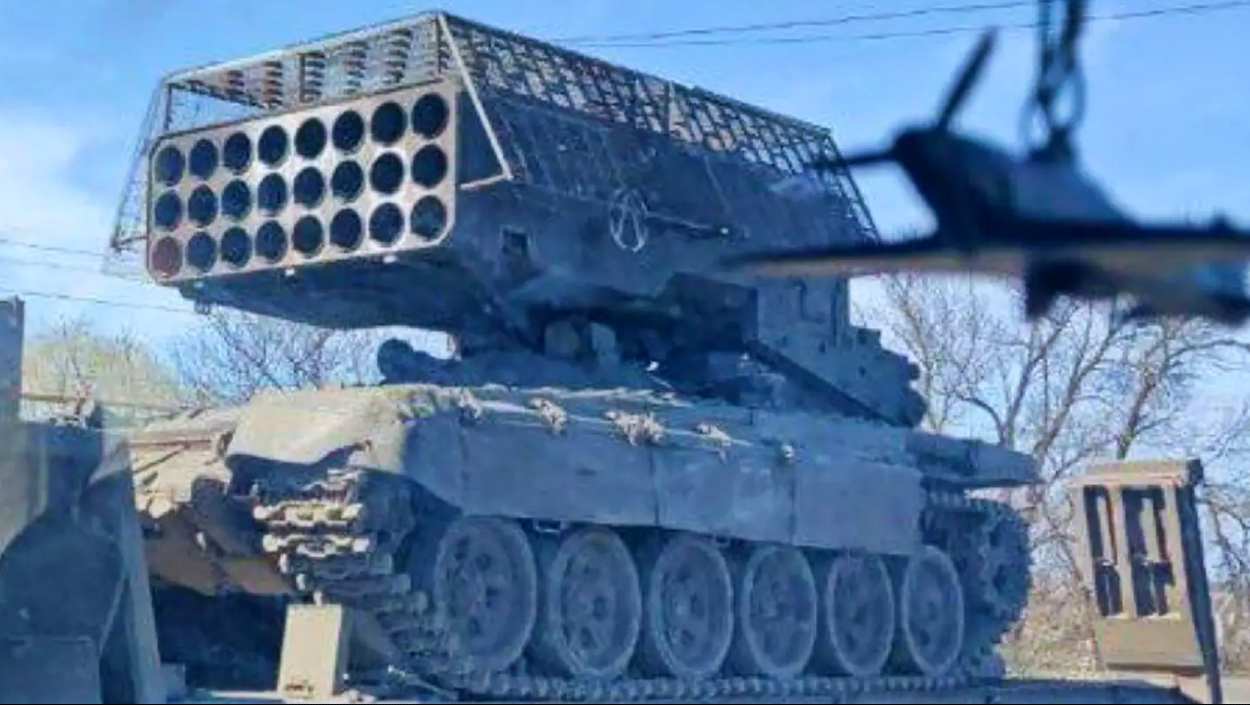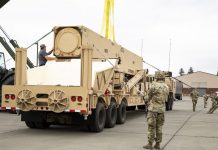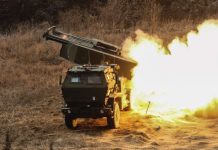After lauding its battle tanks, helicopters, and cope cages, Russian defense and industrial conglomerate Rostec has turned attention to the Solntsepek heavy flamethrower, positioning it as a “joker” in a card deck.
“Solntsepek’s heavy flamethrower is a joker in the NCB deck of cards. The unique thermobaric projectile destroys practically everything. The long shock wave penetrates shelters and bunkers, fills all cracks of the landscape. It thus has a penetrating impact. TOS-1A effectiveness was confirmed in the zone of the special military operation,” the state arms manufacturer said on Telegram, as reported by TASS on July 28.
The “joker” metaphor is indicative of the TOS-1A’s versatility and unpredictability, especially since the system has been projected as a formidable asset capable of turning the tide in combat due to its unique thermobaric capabilities.
However, Rostec’s messaging also admits that the system is not invincible by highlighting that the Ukrainians “always hunt the flamethrowers with drones, artillery, and other weapons.”
The timing of this messaging is intriguing. On July 28, reports indicated that a Russian TOS-1A Solntsepyok heavy flamethrower system was destroyed by an FPV drone strike in the Donetsk region. The visuals of the system engulfed in fire were posted on X. The claims could not be independently verified by the EurAsian Times.
It is possible that by framing the TOS-1A as a “joker” with unmatched destructive power, Rostec seeks to counter Ukrainian claims of neutralizing these systems, portraying them as critical assets that remain a threat despite losses.
A Russian TOS-1A "Solntsepyok" heavy flamethrower system was recently destroyed by a Ukrainian FPV drone strike in Donetsk region. pic.twitter.com/EQmIwVlQ33
— NOELREPORTS 🇪🇺 🇺🇦 (@NOELreports) July 28, 2025
However, it could also be a part of a larger pattern. Russia’s intensified offensive against Ukraine and new gains seem to be accompanied by a campaign projecting Russian weaponry as superior and highly coveted, perhaps to counter the narrative of vulnerability against Ukrainian weapons, and to boost exports.
Earlier, Rostec admired the superior performance displayed by its main battle tanks like the T-90M over Western-origin Leopard-2 and Abrams deployed by Ukraine.
More recently, Rostec took a jibe at the Abrams Main Battle Tanks (MBTs), stating that the Americans initially mocked the drone protection on Russian tanks and then copied it to enhance protection on their tanks.
Though the latest string of messaging about Russian platforms does not directly imply their export prospects, it is barely a secret that the Russian state machinery is vying to push its arms in the global market, after a fall in sales by 64% between 2015–19 and 2020–24.
Russia has been open about its interest in exporting the TOS-1A Solntsepek heavy flamethrower system. In February 2024, Alexander Mikheyev, CEO of Rosoboronexport, stated at the World Defense Show 2024 in Riyadh that Saudi Arabia could potentially purchase the TOS-1A Solntsepek along with other Russian defense equipment.
Since there has been no update on such a deal, it is likely that it has either been shelved or remains in limbo for now.
Why Is The Solntsepek The Joker In The Card Deck?
The TOS-1A “Solntsepek” is a heavy flamethrower system. It is operated by Russia’s NBC (Nuclear, Biological, Chemical) Protection Troops rather than artillery units, reflecting its specialized role in delivering thermobaric and incendiary effects.
Notably, it is categorized as a multiple rocket launcher rather than a conventional flamethrower despite its name.
The chassis of the TOS-1A MBRL system is based on the T-72 main battle tank. The rocket launch facility has taken the turret’s position while maintaining the same overall design. Strengthened steel forms the hull of the vehicle.
The launch vehicle weighs 46,500 kilograms. The system accommodates a crew of three and has been designed to provide direct fire support to complement tanks and infantry fighting vehicles on the battlefield.
The TOS-1A features 24 launch tubes for 220 mm unguided rockets.
The TOS-1A fires unguided rockets with thermobaric (fuel-air explosive) or incendiary warheads that create a high-temperature explosion and prolonged blast wave by dispersing a flammable cloud and igniting it, making them highly effective against personnel, fortifications, and light vehicles. It can fire several rockets in less than a second, with an engagement range of 400 to 6,000 meters. It is capable of firing a full salvo in 6 seconds, covering an area up to 40,000 square meters, comparable to six football pitches.
What makes this system truly lethal is the fact that the initial explosive charge detonates upon impact with the target, causing the fuel container to disperse with the surrounding oxygen and destroying everything in its vicinity. These blast waves of a thermobaric weapon last longer than those of a conventional explosive. The temperature is above 1000 degrees Centigrade.
The system is also very mobile. The vehicle has a maximum speed of 60 kilometers per hour and an endurance of up to 550 kilometers.

The TOS-1A was sighted in rebel-held eastern Ukraine in 2015. The use of the system in the Ukraine War was first confirmed in March 2022 by the UK Ministry of Defense, and it has been extensively deployed in combat since. Russia is known to have delivered the system to the Russian Airborne Forces, as previously reported by the EurAsian Times.
The Solntsepek weapon system has emerged as a critical element of the Russian military’s operations in Ukraine, predominantly employed to launch a concentrated assault on Ukrainian forces. The Russian Ministry of Defense (RuMoD) earlier labeled the Solntsepek (Blazing Sun) as a weapon that “causes panic.” It maintains that the system has no analogs in the world.
However, much like advanced Russian tanks and other ground-based platforms, this Flamethrower is susceptible to attacks by anti-tank guided munitions (ATGMs) as well as cheap First Person View (FPV) drones deployed by Ukraine.
It was very early on in the conflict that Western experts concluded that the best way to prevent Ukraine from the widespread destruction caused by TOS-1A would be to destroy it before it could destroy you.
Russia soon adapted to the evolving threat and equipped the TOS-1A with cope cages, or welded grates, to shield it from drone attacks. Nonetheless, it has lost more than 30 TOS-1A in the conflict, according to Oryx, an open-source Dutch website that collates data on combat losses in the grinding war.

Reports in Ukrainian media in May 2025 indicated that the Ukrainian Border Guards had destroyed a TOS-1A in the Belgorod sector, which has been a site of intense combat between the two sides.
Besides the TOS-1A, Russia has also deployed the TOS-2 Tosochka thermobaric rocket launcher in Ukraine since September 2023.
By November 2024, the Russian state corporation Rostec announced that TOS-2 systems in Ukraine were equipped with new radiation-absorbing camouflage kits developed by Roselectronika. These kits use a special coating to evade detection in optical and near-infrared ranges and protect against precision-guided weapons.
In February this year, the first visually confirmed loss of a TOS-2 was reported in the Pokrovsk direction (Donetsk region), where Ukrainian forces destroyed a system near Petrovka.
Russia is currently known to be working on TOS-3 ‘Dragon’ variant, the latest in the series of these heavy flamethrower systems.
However, as cheap and expendable drones continue to proliferate on the battlefield, none of these advanced and panic-inducing systems are safe.
- Contact the author at sakshi.tiwari9555 (at) gmail.com
- Follow EurAsian Times on Google News




